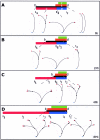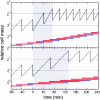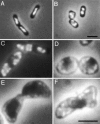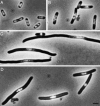Use of thymine limitation and thymine starvation to study bacterial physiology and cytology
- PMID: 16484178
- PMCID: PMC1426543
- DOI: 10.1128/JB.188.5.1667-1679.2006
Use of thymine limitation and thymine starvation to study bacterial physiology and cytology
Figures







Similar articles
-
Effect of thymine limitation of chromosomal deoxyribonucleic acid synthesis in Proteus mirabilis.J Bacteriol. 1972 Sep;111(3):750-7. doi: 10.1128/jb.111.3.750-757.1972. J Bacteriol. 1972. PMID: 4559826 Free PMC article.
-
[Behavior of the DNA of bacteria and spores during the sporal cycle of B. subtilis].Ann Inst Pasteur (Paris). 1968 Dec;115(6):990-1007. Ann Inst Pasteur (Paris). 1968. PMID: 4977152 French. No abstract available.
-
Regulation of chromosome replication and the bacterial cell cycle.Annu Rev Microbiol. 1972;26:347-68. doi: 10.1146/annurev.mi.26.100172.002023. Annu Rev Microbiol. 1972. PMID: 4562814 Review. No abstract available.
-
The effect of thymine starvation on chromosomal structure of Escherichia coli JG-151.Biochem Biophys Res Commun. 1971 Jan 8;42(1):23-30. doi: 10.1016/0006-291x(71)90356-1. Biochem Biophys Res Commun. 1971. PMID: 4927142 No abstract available.
-
[The bacterial cell cycle: DNA replication, nucleoid segregation, and cell division].Mikrobiologiia. 2005 Jul-Aug;74(4):437-51. Mikrobiologiia. 2005. PMID: 16211846 Review. Russian.
Cited by
-
Purine and pyrimidine synthesis differently affect the strength of the inoculum effect for aminoglycoside and β-lactam antibiotics.bioRxiv [Preprint]. 2024 Apr 9:2024.04.09.588696. doi: 10.1101/2024.04.09.588696. bioRxiv. 2024. Update in: Microbiol Spectr. 2024 Oct 22:e0189524. doi: 10.1128/spectrum.01895-24. PMID: 38645041 Free PMC article. Updated. Preprint.
-
The Bacterial Nucleoid: From Electron Microscopy to Polymer Physics-A Personal Recollection.Life (Basel). 2023 Mar 28;13(4):895. doi: 10.3390/life13040895. Life (Basel). 2023. PMID: 37109423 Free PMC article. Review.
-
Sizing up the bacterial cell cycle.Nat Rev Microbiol. 2017 Oct;15(10):606-620. doi: 10.1038/nrmicro.2017.79. Epub 2017 Aug 14. Nat Rev Microbiol. 2017. PMID: 28804128 Review.
-
Chromosomal Replication Complexity: A Novel DNA Metrics and Genome Instability Factor.PLoS Genet. 2016 Oct 6;12(10):e1006229. doi: 10.1371/journal.pgen.1006229. eCollection 2016 Oct. PLoS Genet. 2016. PMID: 27711112 Free PMC article. Review.
-
Different Amounts of DNA in Newborn Cells of Escherichia coli Preclude a Role for the Chromosome in Size Control According to the "Adder" Model.Front Microbiol. 2018 Apr 5;9:664. doi: 10.3389/fmicb.2018.00664. eCollection 2018. Front Microbiol. 2018. PMID: 29675011 Free PMC article.
References
-
- Aarsman, M. E. G., A. Piette, C. Fraipont, T. M. F. Vinkelvleugel, M. Nguyen-Distèche, M., and T. den Blaauwen. 2005. Maturation of the Escherichia coli divisome occurs in two steps. Mol. Microbiol. 55:1631-1645. - PubMed
-
- Ahmad, S. I., S. H. Kirk, and A. Eisenstark. 1998. Thymine metabolism and thymineless death in prokaryotes and eukaryotes. Annu. Rev. Microbiol. 52:591-625. - PubMed
-
- Bazill, G. W. 1967. Lethal unbalanced growth in bacteria. Nature 216:346-349. - PubMed
Publication types
MeSH terms
Substances
LinkOut - more resources
Full Text Sources

